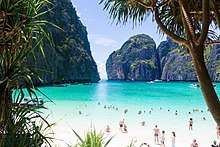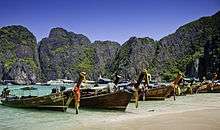Ko Phi Phi Le

Ko Phi Phi Le or Ko Phi Phi Leh (Thai: เกาะพีพีเล, RTGS: ko phiphi le, pronounced [kɔ̀ʔ pʰīː.pʰīː lēː]) is an island of the Phi Phi Archipelago, in the Strait of Malacca. It is in Krabi Province of Thailand and is part of Hat Noppharat Thara–Mu Ko Phi Phi National Park[1]
Geography

Ko Phi Phi Le is the second largest island of the archipelago, the largest one being Ko Phi Phi Don. The island consists of a ring of steep limestone hills surrounding two shallow bays, Maya Bay and Loh Samah. During low tide, Maya Bay cannot be accessed directly from the sea via boat, due to shallow waters and coral. Boats must anchor at the deeper Loh Samah, requiring people to walk through a short section of rocks and jungle to reach Maya Bay itself. There is also one large shallow fjord like inlet called Pi Ley with a small coral reef at the entrance. The Maya Bay area harbors bioluminescent plankton.[2]
Tourism
Hat Noppharat Thara-Mu Ko Phi Phi Marine National Park as a whole, from October 2015 to May 2016 generated revenues of 362 million baht from 1.2 million tourists, 77 percent foreign.[3]
Environmental issues



.jpg)
Controversy arose regarding the 1999 production of the film The Beach, released February 2000, due to 20th Century Fox bulldozing and landscaping the natural beach setting of Ko Phi Phi Le to make it more "paradise-like". The production altered some sand dunes and cleared some coconut trees and grass to widen the beach. Fox set aside a fund to reconstruct and return the beach to its natural state. Nevertheless, lawsuits were filed as many believed the damage to the ecosystem is permanent and restoration attempts failed.
The lawsuits dragged on for years. In 2006, Thailand's supreme court upheld an appeals court ruling that the filming had harmed the environment and ordered that damage assessments be made. Defendants in the case included 20th Century Fox and some Thai government officials.[4]
The Department of National Parks, Wildlife and Plant Conservation claims to be investigating ways to control tourist numbers amid concerns that visitors are destroying the environment at marine tourism spots. The move was prompted by marine scientist Thon Thamrongnawasawat, who posted photos of large numbers of low-season tourists packed onto small Maya Beach. According to Mr Thon, during low season 2016, about 5,000 tourists a day crowd onto Maya beach, which is just 250 metres long and 15 metres wide. The beach has 14 available toilets. Tourists are worth 1.6 million baht a day to the park. Thon said that state agencies were running campaigns to drum up tourist numbers with no regard for the environment's carrying capacity.[3]
In March 2018 Thai authorities announced that Maya Beach would be closed to tourists for four months to allow it to recover from environmental damage due to excessive visitor numbers.[5] The beach receives an estimated 5,000 visitors per day, while 200 boats per day set anchor in the bay. Surveys by marine biologists have found that 80 percent of the coral reefs surrounding the bay have been destroyed by boat traffic and pollution; marine life is virtually nonexistent as a result.[6] When Maya Beach reopens visitor numbers will be limited to 2,000 people per day and boats will have to dock outside the bay.[5] The government will spend 100 million baht to construct a boat parking zone and floating pier to receive tourists. It will use an online ticketing system to manage sales and income from entry fees.[7]
On October 1, 2018, the Thai Department of National Parks, Wildlife and Plant Conservation announced that Maya Beach would be closed indefinitely, because tests performed during the four month closure earlier in the year found the ecological damage to be far more extensive than previously thought. The director of the office, Songtam Suksawang, said that the beach "was completely destroyed, along with the plants which covered it," and that reopening would not occur until the ecosystem "fully recovers to a normal situation."[8]
See also
References
- ↑ "Hat Noppharat Thara - Mu Ko Phi Phi National Park". Department of National Parks (DNP) Thailand. Archived from the original on 21 January 2015. Retrieved 15 June 2015.
- ↑ Hagerty, Colleen (12 May 2015). "A crowded Thai island's secret side". BBC.
- 1 2 Wipatayotin, Apinya (19 July 2016). "Parks Department to curb tourist visits to marine sites". Bangkok Post. Retrieved 19 July 2016.
- ↑ "SUPREME COURT RULING: Filming 'damaged beach'". The Nation. 2006-12-01. Retrieved 15 June 2015.
- 1 2 "Beach from Leonardo DiCaprio film to temporarily close due to tourist damage". The Guardian. Associated Press. 2018-03-28. Retrieved 2018-03-28.
- ↑ Hanna Ellis-Peterson (2018-02-25). "Can a tourist ban save DiCaprio's coral paradise from destruction?". The Guardian. Retrieved 2018-03-28.
- ↑ Wipatayotin, Apinya (3 June 2018). "Rehab effort for Maya Beach set to begin as tourists shut out". Bangkok Post. Retrieved 6 June 2018.
- ↑ Agence France Presse (2018-10-03). "Thailand: bay made famous by The Beach closed indefinitely". The Guardian. Retrieved 2018-10-03.
External links

